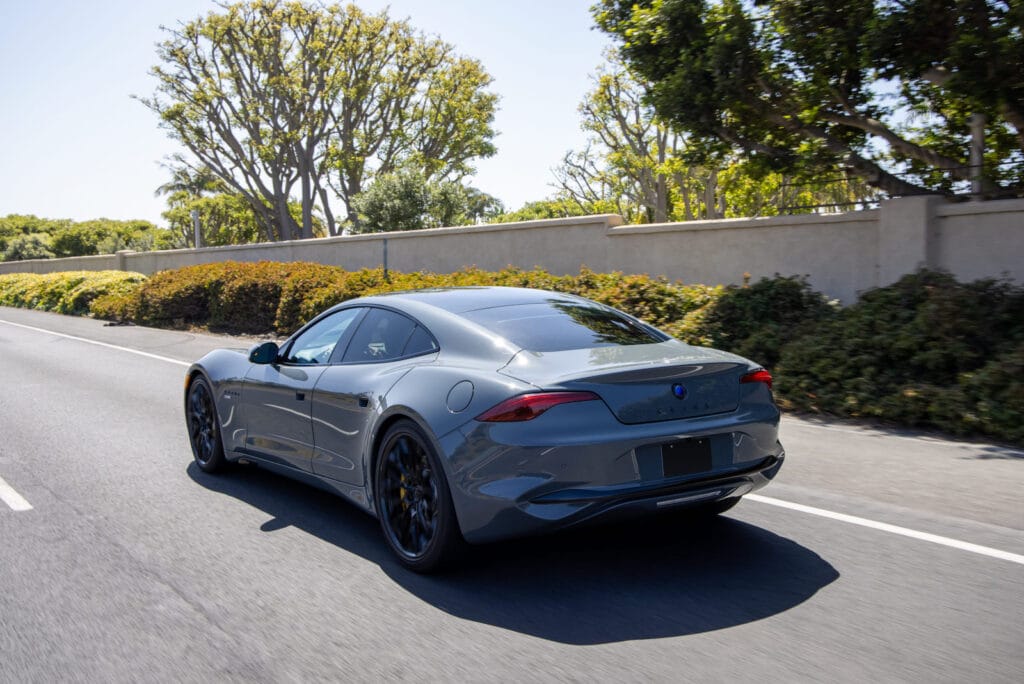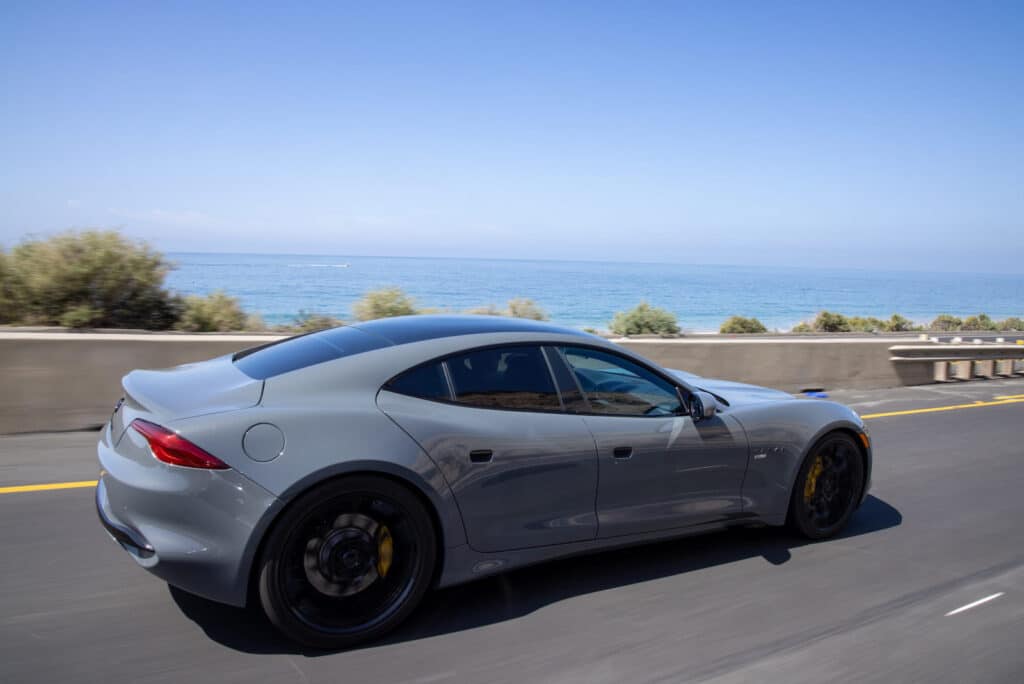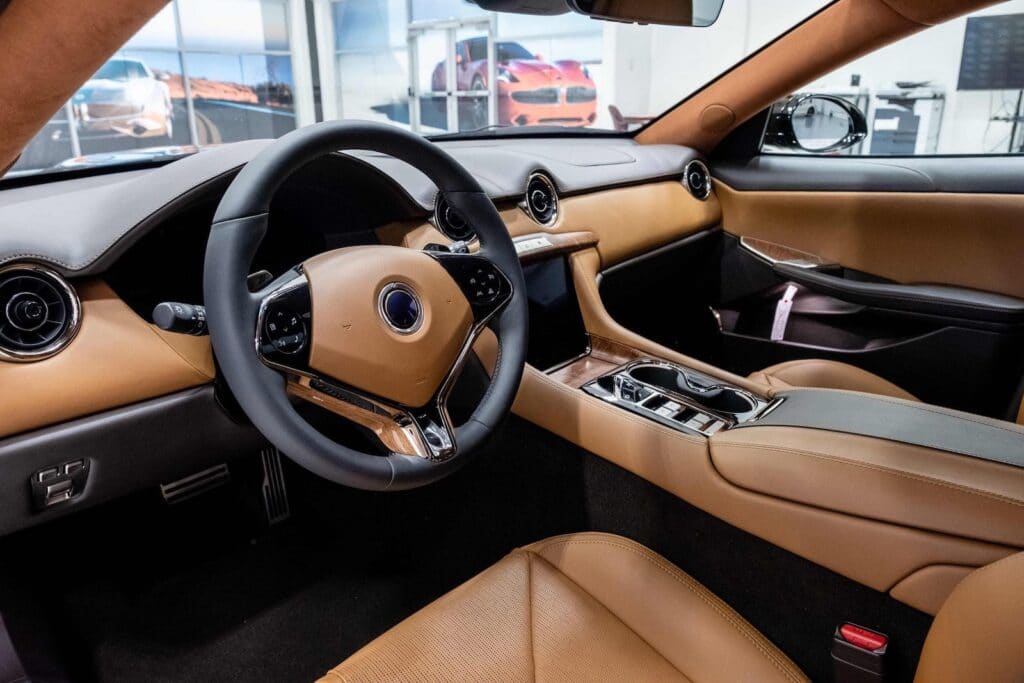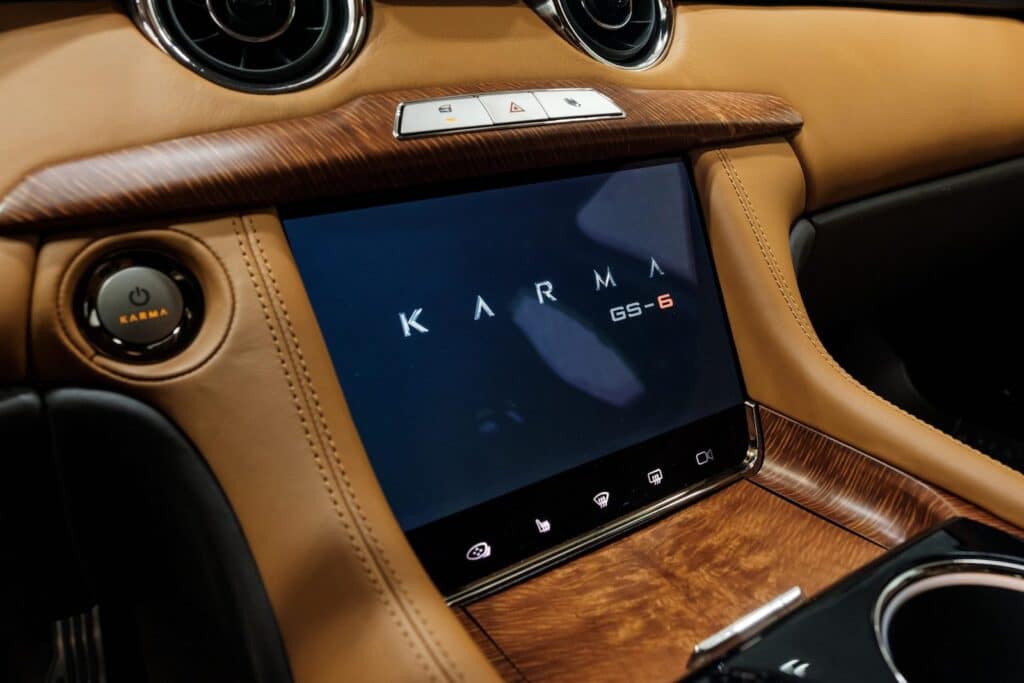In a world of planned obsolescence, a vehicle that looks good today is likely to seem dated just a few years from now. Yet there are the occasional exceptions. And the sports sedan originally known as the Fisker Karma is one of the best examples. It boasted a strikingly sensuous look when it first came to market in 2011. With only the most modest tweaks, it remains a head-turner today. So I discovered during three days behind the wheel of what is now known as the Karma Revero.

The plug-in hybrid seemed destined to suffer an early and ignominious end when, barely two years after its debut, Fisker Automotive plunged into bankruptcy. In a surprise move, the California startup’s assets were purchased by Chinese auto parts company the Wanxiang Group, and the company itself was relaunched as Karma. The original Fisker four-door was rebadged Revero.
Adding to the confusion, there will soon be three different versions, the Karma GS-6L that I drove, the more powerful Karma Revero GT, and an all-electric version to be called the Karma GSe-6.
Overview
The obvious question is: how much has the original Fisker Karma changed, now that a decade has passed? The answer is: surprisingly little, at least from an exterior design perspective. Under Wanxiang’s stewardship, a few of the odder details have been tweaked, starting with the original sedan’s quirky moustache-like grille.
The interior has been updated more significantly, with newer, even more luxurious materials and the addition of technologies not available a decade ago. There’s now a large touchscreen infotainment system, for starters, with Bluetooth, Android Auto and Apple CarPlay.

You’ll have to look under the skin for the most significant changes, however. That includes a new lithium-ion battery pack storing about 40% more energy than the original car’s 20.1 kilowatt-hours. And the range-extending General Motors Ecotec gas engine has been replaced with a more powerful, smoother and quieter BMW powerplant.
Exterior
The Karma-cum-Revero is, to my eyes, the design that Porsche could only dream of for its own sports sedan, the Panamera. And that a good decade after the plug-in first came to market. It is a truly timeless design that turned heads everywhere I went. A week after I returned my test vehicle folks still pulled up to my house asking what I had been driving.
The overall design of the GS-6L is that of a classic grand tourer, rather than a sports car. Henrik Fisker, the original designer of the Karma — and founder of the ill-fated Fisker Automotive — has a long track record of designing timeless and exotic vehicles, including the Aston Martin DB-9. What he came up with here draws from classic sports sedan design but adds the requisite aerodynamic details critical for a car running on battery power, such as the fully flush door handles.

The GS-6L stands barely 52 inches tall, far less than, say, a BMW 4-Series Gran Coupe. Projector LED headlamps sweep back into a long hood which, in turn, flows into a steeply raked windshield and a coupe-like roofline. If you had to compare it to any other recent model, you’d likely have to imagine adding a second pair of doors to the old Dodge Viper GTS Coupe.
Adding to the sporty feel, the GS-6L comes standard with 21-inch Cascade Silver wheels and slate-colored Brembo disc brake calipers — while the top-of-the line GS-6S gets standard 22-inch Dune Twist Midnight Chrome wheels with red Brembo calipers mated to vented discs.
Interior
The interior is where the new sedan boasts the most notable visual update from the original Fisker Karma. It’s got a more refined mix of leather, wood and metal, with some of the parts made from recycled materials, in keeping with the environmental theme of this plug-in hybrid. You can add materials like carbon fiber, as well, Karma offering an extensive range of bespoke options.

Much like the Tesla Model S, Karma has largely eliminated switches and knobs in favor of touchscreen controls — though the GS series adopts a more conventional shape for the digital gauge cluster and a less radical size for the touchscreen atop the center console. Like all too many manufacturers getting into the electric vehicle market, Karma has decided the touchscreen can handle pretty much everything. While that’s technically true, it doesn’t mean it handles everything well. I’d much prefer to have standalone physical controls for functions like adjusting the sideview mirrors and the car’s heated seats.
There’s another concern that could alienate some buyers. While one expects some compromises with interior space with such a low-slung sedan, the cabin becomes even more cramped due to the way the lithium-ion battery is mounted. Unlike the latest EVs, where batteries are mounted under the floor of a skateboard-like platform, here the pack intrudes into the passenger compartment, running north to south between the left and right seats.
The good news is that the front seats are quite comfortable, even after a long drive, but I’d not want to be stuffed into the rear for long.
Powertrain

While I have referred to the GS-6L as a “plug-in hybrid,” the more accurate terms is “extended-range electric vehicle,” or EREV. This is more than a matter of semantics. The Panamera Hybrid, for example, can draw power either from its electric drive system, its gas engine — or by pairing them both up. The wheels of the GS-6L are only ever powered by its two electric motors, one on each axle. In all-electric, or Stealth, mode that will get you an EPA-estimated 61 miles of range out of the 28 kWh battery pack.
While that would be more than enough to handle the daily needs of most American motorists, the GS-6L has that BMW gas engine at the ready when you’re traveling longer distances — or want even more current during hard driving situations.
The new BMW inline-3 cylinder displaces a mere 1.5 liters but it allows the Karma sedan to keep punching out a solid 536 horsepower and 550 pound-feet of torque. And that will get you from 0 to 60 in about 4.5 seconds in Speed Mode. The more expensive GS-6S, with the optional Performance Package, cuts that down to 3.9 seconds.
There is no mechanical link between the gas engine and wheels, it serving solely as a generator. The twin electric motors are each connected to the wheels through single-speed gearboxes.

Safety and Technology
The gauge cluster is completely digital, and there’s a 10.2-inch touchscreen atop the center console. It features Bluetooth, of course, and both Android Auto and Apple CarPlay. The GS-6 can use smartphone-style over-the-air updates to revise onboard software, meanwhile.
You won’t get semi-autonomous technologies, like Tesla’s Autopilot or the GM Super Cruise recently added to the Chevrolet Bolt EUV. But the Karma GS-6L does have a wide range of advanced driver assistance systems, including forward collision warning with autonomous emergency braking and blind-spot detection.
Driving Impressions
There’s a reason why battery propulsion is starting to gain fans when it comes to the performance market. Electric motors deliver virtually 100% of their tire-spinning torque the moment they’re switched on. Shift the GS-6L to its sport mode, stomp the throttle and be prepared for a thrill. While the Karma sedan won’t win a drag race with a Tesla Model S Performance model, it’s close. And for those who want maximum performance, there’s always the top-line Karma Revero GT.

In most circumstances, the Karma sedan operates as quietly as any electric vehicle. Even with the BMW powerplant fired up it’s surprisingly quiet. And the Bavarian I-3 creates a distinctly more appealing note than the old GM Ecotec found in the original Fisker Karma.
Obviously, when you push it hard, you’ll cut into all-electric range, especially when in Stealth mode. I saw a figure closer to 40 miles between charges. To recharge you’ll need 40 minutes using a public DC quick-charger. Using a 240-volt Level 2 charger requires a little more than six hours.
The EPA gives the GS-6L a 70 MPGe combined rating. The more practical figure, at least once the gas engine is running, comes in at a combined 26 mpg.
The GS-6L is reasonably nimble and fun to take through the turns, as I discovered running my familiar test route through Hell, Michigan. But it’s no lightweight, coming in at just over 5,000 pounds. And the higher mounting position of the battery means it doesn’t have the low center of gravity of more recent skateboard-style battery-car designs.
2021 Karma GS-6L specifications
| Dimension | L: 199.5 inches/W: 85.1 inches/H: 52.4 inches/Wheelbase: 124.4 inches |
| Weight | 5,000+ pounds (estimated) |
| Powertrain | 1.5-liter inline 3-cylinder (generator) and 400kW two-motor propulsion system; 28kWh, 358V lithium-ion battery |
| Fuel Economy | 70MPGe/22 mpg combined |
| Performance Specs | 536 horsepower and 550 pound-feet of torque |
| Price | Base price: $93,900; As tested: $114,700 including $1,800 destination and delivery charge |
| On-Sale Date | Available now |
Wrap Up
The Karma EREV powertrain isn’t the most modern in the plug-in segment, but the compromises are relatively modest — primarily with the way the battery layout intrudes into the passenger compartment. It does compare well in terms of performance.
Where the GS-6 family does win out is in terms of design. After a decade, it remains one of the freshest looking models on the market, whether conventionally powered or using some form of electric drivetrain.
The GS-6 line will be offered in a variety of configurations by year-end. The base model starts at $85,700, with the GS-6L coming in at $95,700. The GS-6S will set you back $105,700. There’s no word on pricing for the upcoming GSe-6 all-electric model. After loading up on features like carbon fiber trim and 22-inch wheels, my test GS-6L jumped to $114,700 — which also included an $1,800 delivery fee.
Karma’s new factory in Southern California has the capacity to produce about 15,000 vehicles annually. While that means the GS-6L might not be as exclusive as some exotics, it’s going to be rare enough to be a truly distinctive choice. And, even after a decade, this remains one of the most visually appealing sports sedans on the road. Be prepared to have a lot of folks asking about what you’re driving.

